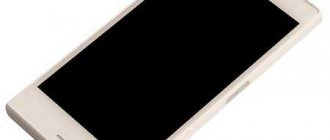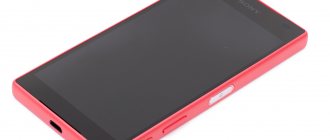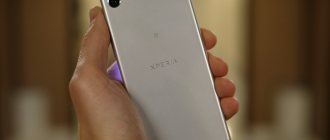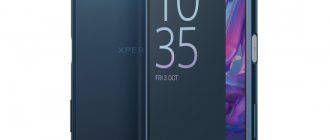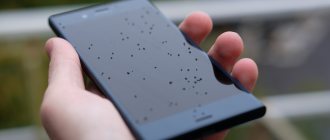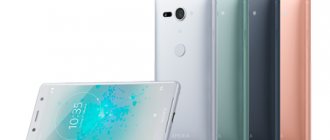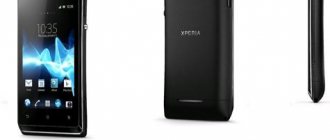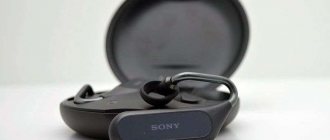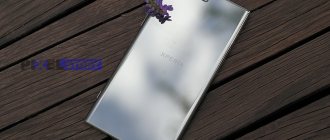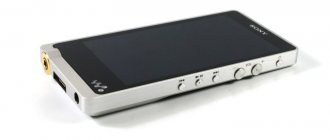Tactile sensation and design
From the point of view of tactile sensations, the smartphone seemed convincing to us even at the first touch. For a top-end smartphone, the device is unexpectedly thick, but the device fits very well in the hand because you can comfortably wrap your fingers around it. One-handed operation is also very easy. Even though the body is made of plastic, we really liked the matte black back of the variant we tested.
It does not have the glamorous effect of glass phones, but in itself it makes a solid impression and pleases with its excellent workmanship. Fingerprints can be seen, but only if you look at the case at a certain angle to the light source, and for the most part they are not noticeable. In addition, the XZ1 Compact is waterproof. What we do find somewhat disturbing, however, are the non-rounded corners of the device, which put a little pressure on the pad of the palm at the base of the thumb.
The Xperia XZ1 Compact fits well in the hand - only the corners are a little tight
At the peak of urban comfort
As a result, the combination of XZ1 Compact and MDR-1000X, as I already said, is well suited for the city. A compact smartphone does not weigh on your pocket and does not tend to fall onto the asphalt, headphones connected via a wireless interface will not get caught on various railings and other ledges that abound in the urban environment, and the noise reduction system quite effectively disconnects the user from the outside world and transports him to the world of music or movies.
The large and large cups of the MDR-1000X warm the ears well in cool weather and are a noticeable indicator that you should not touch a person - he is somewhere out there, far away, hidden in his house where the high-rez are playing. The high-rez plays well, better than MP3. The sound is standard for quality Sony products. But, oddly enough, liveliness and emotions can be added to it due to noise reduction.
The smartphone itself looks straight out of 2014, but in terms of characteristics, performance and daily use scenarios it can give odds to blade flagships. At least due to the fact that you can actually operate it with one hand, without fear of dislocating your finger. And in a difficult situation, you can throw it at the forehead of an enemy hiding in the gateway - I suspect that the XZ1 Compact will withstand this meeting quite well.
At the same time, the devices did not work perfectly with each other. A couple of times it took me up to ten minutes to connect them and start listening to music. Touch playback controls occasionally did not work, and sometimes worked too sensitively. After all, the MDR-1000X uses a MicroUSB connector, while the XZ1 Compact uses Type C, so you have to carry two wires instead of one with you in case of emergency charging.
But the feeling of comfort that this set gives, perhaps, may be to the taste of many.
Advantages: compactness and comfort, interaction within the Sony ecosystem, flexible sound settings, multifaceted noise reduction
Disadvantages: strange behavior of the headphone touch controls, outdated but cute smartphone design
Official website: Sony Xperia XZ1 Compact, Sony MDR-1000X
Price: Sony Xperia XZ1 Compact - 39,990 rubles, Sony MDR-1000X - 27,990 rubles
Bright screen with mediocre resolution
With its rather small 4.6-inch display, the Xperia XZ1 Compact is less suitable for multimedia lovers who regularly watch videos on a smartphone screen. Despite its mediocre resolution, the display offers very good image quality. Particularly striking is the maximum brightness, which reaches 658 cd/m2 and allows you to read content without problems even in bright sunlight. The color reproduction of the LC display looks natural to our tastes, although it is not as impressive as that of AMOLED displays.
Sony can be slightly criticized for the fact that its line of compact models has only HD resolution (1280x720 pixels), and because of this the image density reaches only 320 ppi. Compared to higher resolution screens, you'll notice a jagged effect around the edges of the letters and a slight blurriness - if you pay attention to it at all. If you don't have another device handy for direct comparison, you may find image clarity to be excellent (it's on par with the iPhone 8), although Full-HD resolution could be a little more enjoyable.
Smartphone cameras
During the presentation, the emphasis was placed on cameras and their additional capabilities. The Xperia XZ1 Compact has the latest 19-megapixel Motion Eye module with its own 128 MB buffer memory, which allows you to record video with super slow motion up to 960fps. It has predictive autofocus that follows a moving object, intelligent image capture, additional sensors: an infrared sensor and laser autofocus. We will find out whether the processing algorithms will differ significantly after we personally get acquainted with the smartphone.
Among the innovations, it is also worth mentioning the fancy 3D scanning function - thanks to the camera and software, you can make a virtual three-dimensional model of the head, products and other objects and use it for stickers or print the model on a printer. Cool, but not vital.
The front camera has a resolution of 8 megapixels, which is less than the Xperia XZ1's 13 megapixel module, but the lens size is larger. The 18mm ultra-wide-angle lens allows you to take selfies with a 120-degree field of view, allowing you to fit even more into the frame. The choice between 80 degrees and 120 degrees is done in the camera application with just one button.
Fantastic battery life
But the battery life of the Xperia XZ1 Compact is fantastic. During our tests in "online" mode with an activated LTE connection, it lasted a full 13 hours and 45 minutes while playing videos and scrolling websites. This is an excellent result. Only the truly one-sidedly talented LG X Power 2 can work longer without recharging. Unfortunately, the overall duration of the charging process can be considered typical for Sony: we had to wait almost three hours until the battery was fully charged during testing.
Despite its remarkable battery life, the performance of the Sony Xperia XZ1 Compact is beyond doubt. The smartphone is powered by the fastest mobile processor currently available, Qualcomm Snapdragon 835, and responds to commands with lightning speed. In some parameters, during testing, it surpassed even the Galaxy S8. For example, it loaded a test website in just 4.4 seconds, while Samsung's top model took 8.4 seconds to complete the same task. The best result was shown by the iPhone 8 - 0.2 s.
The smartphone is charged via the USB Type-C connector
Bottom line
The compact version of the Sony Xperia XZ1, costing about $600 (RUR 36,000), boasts a durable battery, a powerful processor and an excellent camera. It's not bad, but pay $100 more and you'll get the iPhone 8 with a better screen, superior stereo speakers and signature design.
I can't recommend the new Xperia XZ1 Compact to anyone, especially considering its price.
Benefits of Sony Xperia XZ1 Compact
- Long work without recharging
- Compact and convenient
- High performance
- Useful camera features
Disadvantages of Xperia XZ1 Compact
- Inconvenient power/lock button
- Mediocre design
- Overcharge
The camera leaves much to be desired
The Sony Xperia XZ1 Compact has the same camera as its larger sister model, the Sony Xperia XZ1. The quality of the photographs is also similar. This section will be brief, as a more detailed discussion of the 19-megapixel camera with 960 fps slow-mo mode can be found in the XZ1 test report.
The quality of the photos does not quite meet the requirements of the top segment: since the camera’s resolution is very high, the noise level in the images is significantly higher than average, and rather zealous blur algorithms try to combat all this. Both of these significantly reduce image quality, this is especially noticeable in comparison with the results of such top models as the HTC U11. For example, individual hairs on our artificial head become difficult to distinguish - in dim lighting this effect is only enhanced. However, despite all these criticisms, you can still take decent photos in good lighting.
The model we tested had one distinctive feature: in the upper left corner, the scene being filmed was significantly less clear than throughout the rest of the frame. We assume that this was the result of a loose fit of the optics and is an individual shortcoming of a particular specimen, which should not be found on other models.
The camera takes decent photos - but we've seen better
⇡#Camera
The XZ1 Compact uses exactly the same camera as the Sony Xperia XZ1 and XZ Premium - a rapidly aging single camera, 19 megapixels, ƒ/2.0 aperture, optical stabilizer. And all the family problems that plague Sony mobile cameras from year to year have not gone away either - hello, too high resolution along with mediocre color rendition. Why the manufacturer of the world's best sensors, which are used in almost all modern phones, cannot provide the same shooting quality as the others - this question has been occupying the minds of people interested in smartphones for a long time. And it is impossible to get an answer to it.
The camera app remains unchanged from what we saw last year and is quite easy to use. But some unnecessary things are a thing of the past, like the “pixel combining” mode, in which by default the Xperia took low-resolution photos without actually improving them.
| Sony Xperia XZ1 Compact camera interface | ||
The quality of regular shooting, as I wrote above, is not very impressive. During the day, the XZ1 Compact produces fairly detailed images with a slightly cold color rendition (which can be slightly adjusted in the settings, there are saturation and brightness adjustments), but at night the smartphone camera is almost helpless, despite the built-in optical stabilizer. Unfortunately, Sony is again inferior to almost all competitors in terms of photography.
Sony Xperia XZ1 Compact: gallery
View all images (27)This year the Xperia camera has its own features. Firstly, it is the ability to create three-dimensional models based on photographs taken in a separate program - 3D creator. You can scan a face, head, food, or random objects, which can then be uploaded for viewing on Sketchfab. There is almost no practical benefit from this - yes, you can 3D print a friend's head, but, seriously, do you need that? But you can have a lot of fun. This is a “play with it and forget it” application, but why not.
Secondly, it is the ability to shoot one-second videos in HD resolution (720p) at a frequency of 960 frames per second. In order to include such a fragment in a video that is recorded at a standard frequency, you will need some skill: it is almost impossible to record a random moment in this format; you need to know in advance what exactly you want to record.
Here are a couple of slow motion examples - it took me about 20 takes to get this result. At the usual frequency, the XZ1 Compact can shoot videos with 4K resolution.
The front camera on the XZ1 Compact is installed simpler than on the XZ1 or XZ Premium - it is a standard 8-megapixel module with an aperture of ƒ/2.4 and without autofocus. I will only note the very wide-angle optics, which will come in handy when shooting group self-portraits, but for single selfies the optical distortion will be too great. A special mode is provided for this, but in it the camera sacrifices shooting quality for the sake of normalizing facial proportions.
Differences from XZ1 in equipment
The large and small Xperia XZ1 models differ slightly from each other in terms of equipment. The compact version, unfortunately, has only 23.3 GB of free space in the built-in storage - the XZ1 has more than 54 GB available for use. However, both models offer a slot for MicroSD memory cards. Sony has somewhat reduced the characteristics of the USB interface in the smaller model, whose USB Type-C port transmits data using the slow USB-2.0 standard. The larger model has a USB Type-C 3.1 port.
Another difference lies in the front camera. The XZ1 Compact has an 8-megapixel resolution with a wide-angle function, which the XZ1 does not have with its front camera having a higher 12-megapixel resolution. In LTE networks, the XZ1 Compact can operate at speeds of up to 800 Mbit/s. The larger model can offer speeds up to 200 Mbps faster. However, this is more of an academic distinction, since as of October 2020, the fastest networks in Germany offer speeds below 500 Mbps. A fast and accurate fingerprint scanner under the side power button, as well as support for Bluetooth 5.0, are on board both devices being compared.
The fingerprint scanner is located under the power on/off button
Other information about the rather funny, but in our opinion not so necessary 3D scanner, as well as the Android 8 operating system used here under the Sony user interface, can be found in the article with a report on the Xperia XZ1 testing results.
Autonomy
Like the 5.2-inch Xperia XZ1, the Compact is equipped with a 2700 mAh battery. Energy-efficient processor + small screen with HD resolution + Android 8.0 Oreo innovations that have a positive effect on battery life = a couple of days without recharging with average use. The smartphone claims to be the most autonomous in the Sony lineup. In video playback mode, it can go without recharging for about 14 hours; the smartphone will last about an hour longer when surfing the web. Support for QuickCharge 3.0 fast charging technology is declared. In about an hour and a half, you can fully charge your smartphone battery.
Alternative: Samsung Galaxy S7
Although one generation older, Samsung's Galaxy S7 is still a recommendable alternative. It's a little larger than the XZ1 Compact, but feels great in the hand. Overall, it performed slightly better in our testing, although it can't compete with Sony's excellent battery life.
Display
HD resolution in 2020? Yes. Which is quite enough for a screen with a resolution of 4.6 inches. This provides a pixel density of 319 PPI. Does it make sense to chase even more dots per inch? I think that many users will prefer the extra minutes of battery life. Moreover, the display of the Sony Xperia XZ1 Compact is quite good. The matrix is made using IPS technology, there is no air gap, the touch is responsive and supports up to 10 simultaneous touches. The Sony Xperia XZ1 Compact screen has decent viewing angles and decent color rendition. The display, like the older smartphone of the tandem, is covered with scratch-resistant glass from Corning of the fifth generation.
In general, there cannot be any serious complaints about the display. Yes, you can find fault, they say, for such money it’s only HD resolution, but the diagonal is very small by today’s standards. Moreover, as already mentioned, resolution has a positive effect on battery life, which is also facilitated by the processor.
Characteristics and test results of Sony Xperia XZ1 Compact
| Price-quality ratio | 92 |
| OS during testing | Android 8.0 |
| Weight | 141 |
| Height x width | 130 x 65 mm; |
| Thickness | 9.6 mm; |
| Screen: diagonal | 4.6 inches |
| Screen: size in mm | 57 x 101 mm; |
| Screen: type | LCD |
| Screen: resolution | 720 x 1,280 pixels |
| Screen: Dot Density | 321 ppi |
| Screen: max. brightness | 658.1 cd/m² |
| Screen: staggered contrast in a dark room | 129 :1 |
| Download speed: PDF 5 MB via WLAN | 5.7 s |
| Download speed: chip.de test chart via WLAN | 6.6 s |
| CPU | Qualcomm Snapdragon 835 |
| CPU frequency | 2.450 MHz |
| Number of CPU cores | 4+4 |
| RAM capacity | 4 GB |
| Battery: capacity | 2.700 mAh |
| Battery: surfing time | 13:43 h:min |
| Battery: charging time | 2:54 h:min |
| Fast charging function | — |
| Battery: discharging time/charging time | 4,7 |
| Wireless charging function | — |
| WLAN | 802.11n, ac |
| VoLTE | Yes |
| LTE: frequencies | 800, 1.800, 2.600 MHz |
| LTE: speed | up to 1,000 Mbit/s |
| Camera: resolution | 19.2 megapixels |
| Camera: measured resolution | 1,856 line pairs |
| Camera: expert assessment of image quality | Fine |
| Camera: VN1 noise | 2.2 VN1 |
| Camera: Optical Image Stabilizer | — |
| Camera: autofocus | Yes |
| Video resolution | 3.840 x 2.160 pixels |
| Front camera: resolution | 8.0 megapixels |
| LED indicator | multicolor |
| SIM card type | Nano-SIM |
| Dual SIM | — |
| Protection against dust and moisture (IP certificate) | IP68 |
| Biometric unlocking | fingerprint sensor |
| User accessible memory | 32 GB |
| Free memory | 22.8 GB |
| Memory card slot | Yes |
| USB connector | Type-C-USB 2.0 |
| Bluetooth | 5 |
| NFC | Yes |
| Headphone output | 3.5mm socket |
| SAR | 1.36 W/kg |
| Firmware version during testing | 47.1.A.2.324 |
| Test date | 2017-10-12 |
⇡#Technical characteristics
| Sony Xperia XZ1 Compact | Sony Xperia X Compact | Sony Xperia XZ1 | Honor 9 | Xiaomi Mi6 | |
| Display | 4.6 inches, IPS, 1280 × 720 pixels, 320 ppi, capacitive multi-touch | 4.6 inches, IPS, 1280 × 720 pixels, 320 ppi, capacitive multi-touch | 5.2 inches, IPS, 1920 × 1080, 424 ppi, capacitive multi-touch | 5.15 inches, IPS, 1920 × 1080 pixels, 423 ppi, capacitive multi-touch | 5.15 inches, IPS, 1920 × 1080 pixels, 428 ppi, capacitive multi-touch |
| Protective glass | Corning Gorilla Glass 5 | Corning Gorilla Glass (modification not specified) | Corning Gorilla Glass 5 | No information | Yes, manufacturer unknown |
| CPU | Qualcomm Snapdragon 835: Quad Kryo 2.45 GHz + Quad Kryo 1.9 GHz | Qualcomm Snapdragon 650: two ARM Cortex-A72 cores, 1.8 GHz + four ARM Cortex-A53 cores, 1.4 GHz | Qualcomm Snapdragon 835: Quad Kryo 2.45 GHz + Quad Kryo 1.9 GHz | HiSilicone Kirin 960: four ARM Cortex-A73 cores, 2.4 GHz + four ARM Cortex-A53 cores, 1.8 GHz | Qualcomm Snapdragon 835: Quad Kryo 2.45 GHz + Quad Kryo 1.9 GHz |
| Graphics controller | Adreno 540, 710 MHz | Adreno 510, 550 MHz | Adreno 540, 710 MHz | ARM Mali-G71 MP8, 850 MHz | Adreno 540, 710 MHz |
| RAM | 4 GB | 3 GB | 4 GB | 4 GB (6 GB version available) | 6 GB |
| Flash memory | 32 GB | 32 GB | 64 GB | 64 GB (there is a version with 128 GB) | 64/128 GB |
| Memory card support | Eat | Eat | Eat | Eat | No |
| Connectors | USB Type-C, 3.5 mm minijack | USB Type-C, 3.5 mm minijack | USB Type-C, 3.5 mm minijack | USB Type-C, 3.5 mm minijack | USB Type-C |
| SIM cards | One nano-SIM | One nano-SIM | Two nano-SIMs | Two nano-SIMs | Two nano-SIMs |
| Cellular connection 2G | GSM 850 / 900 / 1800 / 1900 MHz | GSM 850 / 900 / 1800 / 1900 MHz | GSM 850 / 900 / 1800 / 1900 MHz | GSM 850/900/1800/1900 MHz | GSM 850/900/1800/1900 MHz |
| Cellular 3G | DC-HSPA 800/850/900/1700/1900/2100 MHz | HSDPA 850 / 900 / 1700 / 1900 / 2100 MHz | DC-HSPA 850/900/1900/2100 MHz | HSDPA 850/900/1900/2100 | HSDPA 850/900/1900/2100 |
| Cellular 4G | LTE Cat.15 (up to 800 Mbps): bands 1, 2, 3, 4, 5, 7, 8, 12, 13, 17, 19, 20, 25, 26, 28, 29, 32, 38, 39 , 40, 41, 66 | LTE Cat. 6 (up to 300 Mbit/s): bands 1, 2, 3, 4, 5, 7, 8, 12, 17, 19, 20, 27, 28, 38, 39, 40, 41 | LTE Cat.16 (up to 1024 Mbps): bands 1, 3, 4, 5, 7, 8, 12, 17, 20, 28, 32, 38, 39, 40, 41 | LTE Cat. 6 (300/50 Mbit/s): bands 1, 3, 5, 7, 8, 20, 38, 40, 41 | LTE Cat. 16 (1000/150 Mbit/s): bands 1, 3, 5, 7, 8, 38, 39, 40, 41 |
| WiFi | 802.11a/b/g/n/ac, 2.4 and 5 GHz | 802.11a/b/g/n/ac, 2.4 and 5 GHz | 802.11a/b/g/n/ac, 2.4 and 5 GHz | 802.11a/b/g/n/ac | 802.11a/b/g/n/ac |
| Bluetooth | 5.0 | 4.2 | 5.0 | 4.2 | 5.0 |
| NFC | Eat | Eat | Eat | Eat | Eat |
| Navigation | GPS, A-GPS, GLONASS | GPS, A-GPS, GLONASS, BeiDou | GPS, A-GPS, GLONASS | GPS, A-GPS, GLONASS, BeiDou | GPS, A-GPS, GLONASS, BeiDou |
| Sensors | Illumination, proximity, accelerometer/gyroscope, magnetometer (digital compass) | Illumination, proximity, accelerometer/gyroscope, magnetometer (digital compass), barometer, color spectrum sensor | Illumination, proximity, accelerometer/gyroscope, magnetometer (digital compass) | Light, proximity, accelerometer/gyroscope, magnetometer (digital compass), IR sensor | Light, proximity, accelerometer/gyroscope, magnetometer (digital compass), barometer, IR sensor |
| Fingerprint's scanner | Eat | Eat | Eat | Eat | Eat |
| Main camera | 19 MP, ƒ/2.0, optical stabilization, laser autofocus, LED flash, 4K video recording | 23 MP, ƒ/2.0, predictive hybrid autofocus, LED flash, 4K video recording | 19 MP, ƒ/2.0, optical stabilization, laser autofocus, LED flash, 4K video recording | Dual module, 20 + 12 MP, ƒ/2.2, hybrid autofocus, dual LED flash | Dual module, 12 MP: 27 mm, ƒ/1.8 + 52 mm, ƒ/2.6 (2x zoom); Optical stabilizer operates at wide angles; phase detection autofocus, dual LED flash |
| Front-camera | 8 MP, ƒ/2.4, fixed focus, no flash | 5 MP, fixed focus | 13 MP, ƒ/2.0, contrast autofocus, no flash | 8 MP, ƒ/2.4, fixed focus | 8 MP, fixed focus |
| Nutrition | Non-removable 10.26 Wh battery (2700 mAh, 3.8 V) | Non-removable 10.26 Wh battery (2700 mAh, 3.8 V) | Non-removable 10.26 Wh battery (2700 mAh, 3.8 V) | Non-removable battery 12.16 Wh (3200 mAh, 3.8 V) | Non-removable 12.73 Wh battery (3350 mAh, 3.8 V) |
| Size | 129 × 65 × 9.3 mm | 129 × 65 × 9.5 mm | 148 × 73 × 7.4 mm | 147.3 × 70.9 × 7.45 mm | 145.2 × 70.5 × 7.45 mm |
| Weight | 143 grams | 135 grams | 156 grams | 155 grams | 168/182 grams (regular/ceramic version) |
| Housing protection | IP65/68 | No | IP65/68 | No | Splash protection |
| operating system | Android 8.0 Oreo, Sony Xperia shell | Android 6.0 Marshmallow, Sony Xperia shell | Android 8.0 Oreo, Sony Xperia shell | Android 7.0 Nougat, own EMUI shell | Android 7.1.1 Nougat, MIUI shell |
| Current price | 39,990 rubles | 22,900 rubles | 49,990 rubles | 24,990 rubles | 27,100 rubles |
| Sony Xperia XZ1 Compact – information about the filling according to the CPU Z application | ||||
